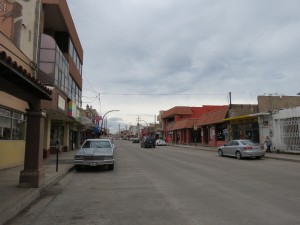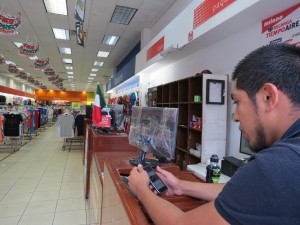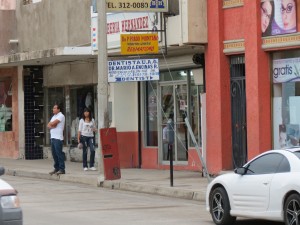
The sidewalks lining Calle Alvaro Obregón were packed with families – men, women and children craning their necks to watch red, white and green floats parade down the main street of Nogales, Sonora.
A military procession followed vaqueros on horseback, children in school uniforms and girls in traditional Mexican dresses. The colors of Mexico hung proudly across the road in streamers. It was the Mexican Independence Day parade on Sept. 16, 2011.
Exactly three years later on a Tuesday afternoon, the same street was there – the same streamers hung up over it – but the road was empty.
A dozen or so policemen patrolled up and down the vacant streets on motorcycles and bikes – “Tourist Police” printed in bold,black letters on their neon green vests – but there wasn’t a tourist in sight.
“I haven’t seen an American tourist in months,” said Berta Guerrero Ojeda, owner of Bertha’s Curios Gift Shop and one of many frustrated merchants on Calle Alvaro Obregón. “In fact, I have seen less and less business in my store each year.”
Restaurant employee Jesús Enrique Borgez echoed her frustration, saying he has given up on tourists coming into Cafetería La Tradición, the restaurant where he works. Instead, he and other employees focus on serving locals, feeling they have nothing to offer tourists, Borgez said.
Mexico border towns near Yuma like Los Algodones and the larger city of Mexicali expect to see a large influx of winter visitors in upcoming months – tens of thousands of tourists from both the U.S. and Canada, according to Ann Walker, the media relations specialist for Visit Yuma.
Most are looking to get dental work, eye care and cheap prescription medications across the border, Walker said.
But pharmacies and dentist clinics in Nogales – also known to bring in consumers from over the border – are struggling, some seeing only three or four tourists a day during the week, and 15-20 on the weekends, according to several business owners.

“Sometimes we can’t afford rent,” said Raúl Molina, whose family owns local pharmacy Cocól Farmacía. “We count on big days like the weekends to make enough to pay it.”
He said sometimes this is still not enough.
Walking around, nothing seemed to have changed since last November when tourists still stayed away because of spikes in Nogales street violence in 2009 and 2010. The only differences this year were a newly repaired main street and the tourist police patrolling it.
Both were projects the local government carried out over the past year to draw more tourists. Reparations for the main street, which began in May and cost the city an estimated 130 million pesos, are in their final stages. The city repaved the road and fixed potholes, but reconstruction will not be complete until the sidewalks are also repaired, said Ángel Molina, the program coordinator from the Nogales Tourism Board.
“We wanted to make the road more tourist friendly,” Molina said. “We’re happy with the results.”
“Our goal is to get people over the border to see the positive side of Mexico,” said Alvaro Heredia, who works with Molina on the tourism board. “As Nogales residents, we saw the increase in violence four or five years ago. But we also know it’s safe now. We want others to see that, too.”
According to the most recent U.S. State Department travel warning for Mexico issued Aug. 15, the reported number of murdered U.S. citizens in Mexico was 71 in 2012 and 81 in 2013. Nearly 70 Americans were reportedly kidnapped between January and June this year.
But Nogales residents, business owners and officials alike insist they are untouched by the violence and urge U.S. tourists to come see the peaceful streets for themselves.
To promote a safer feeling for visitors, the government hired tourist police to secure Calle Alvaro Obregón. This project is also in its final stages. The police are out on the street, but they still need to undergo specialized training, including English and tourism classes.
“We want any person to be able to walk up to them and ask a question,” Molina said.

Yet despite these efforts, and despite reported efforts of Nogales Mayor Ramón Gúzman to bring Arizona mayors across the border to show them around the city, merchants and business owners are still seeing few customers from the U.S. or otherwise.
Arizona, however, has seen an increase in Mexican shoppers on its side of the border, especially within the last year.
Nogales, Ariz., made a little more than $6 million in sales tax in the 2013-2014 fiscal year, according to the city’s monthly financial report from January 2014. That was about $200,000 or 4 percent more than the previous sales period.
This is because more Mexican shoppers are crossing the border to shop at Wal-Mart and grocery stores in Arizona, said Aaron White, the economic development specialist for the city of Nogales, Ariz.
But according to some in Nogales, Son., residents on the Arizona side do not reciprocate, hardly ever coming to shop in Mexico.
Some said it’s because the Mexican government is not doing enough to bring tourists to their side of the border, and others said they think the government is lying.
“It’s all a front,” said advertiser José Luis Lomeli Quintero, who works to promote dentist clinics around town. “The mayor only cares about his own objectives. If he actually cared, he’d go across the border and promote tourism there, bring people over. But he doesn’t.”
Other storeowners and merchants agreed. They said they had heard Mayor Gúzman showed Tucson Mayor Jonathan Rothschild around Nogales, but didn’t do anything after that.
“Whatever the mayor says is a lie,” said Borgez, sitting outside Cafetería La Tradición. “It just is.”
“Because our government does nothing, we have become clients to the U.S., not the other way around. We have nothing to offer American tourists,” Quintero said.
Molina said this simply isn’t true.
“We have studies that show tourism has actually increased over the past year in Nogales,” he said, but was unable to provide numbers from the study. “These are all just opinions. Merchants are not well informed.”

Molina said they are trying to incorporate more merchants into planning by appointing them to the tourism board. “We want to reach out to them,” he said. “We want their input and we want to help because they’ve been hit the hardest.”
He said the tourism board plans to update stores and their merchandise over the next year because the biggest problem is that shopkeepers haven’t kept up with changing tourism trends and don’t know what to sell. The board just got a budget approved to conduct an in-depth study of the tourism industry so they can advise shopkeepers on what to offer, according to Molina.
He also said few merchants have taken advantage of statewide loans they can use to update their storefronts, and encouraged them to do so.
The board also plans to build a shopping plaza called Little Mexico, where people will be able to experience food, music and gifts from every state of Mexico. The federal government recently approved the plan, but the budget is yet to be approved, Molina said.
“We have more projects approved than any other city,” he said. Now the board just has to wait for the federal government to approve each budget for 2015.
Locals, however, said they are not convinced.
“It’s a fallacy – that Mexico is capable of growth,” Quintero said. “Governments everywhere continue to lie to the people, continue to spend money. This is why Mexico does not advance.”
“I have no hope for the future,” Borgez said. “Maybe far, far into the future; maybe. But to be honest, not right now.”
Other merchants are looking forward to the next upcoming months. October through January are supposed to be a bit busier, they said.
Contact reporter at maizie7@email.arizona.edu or follow her on Twitter at @maizie_simpson.

